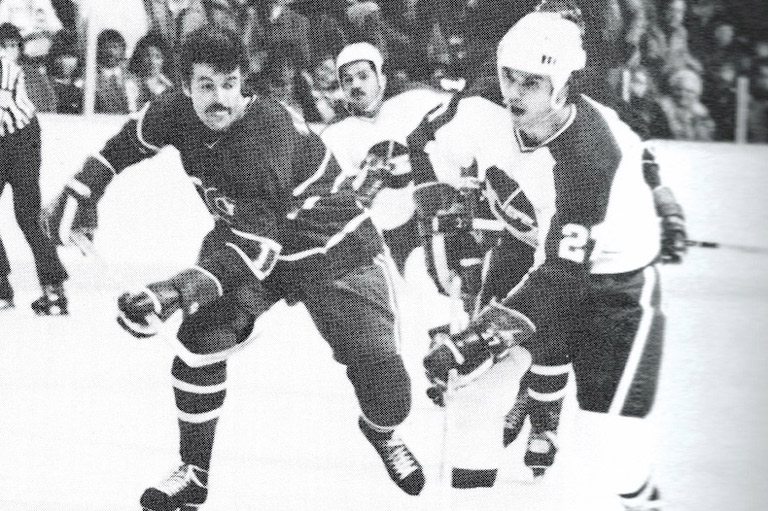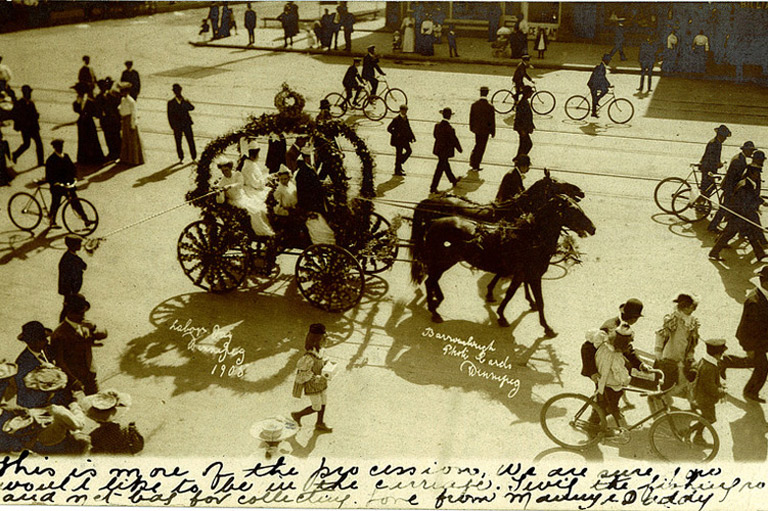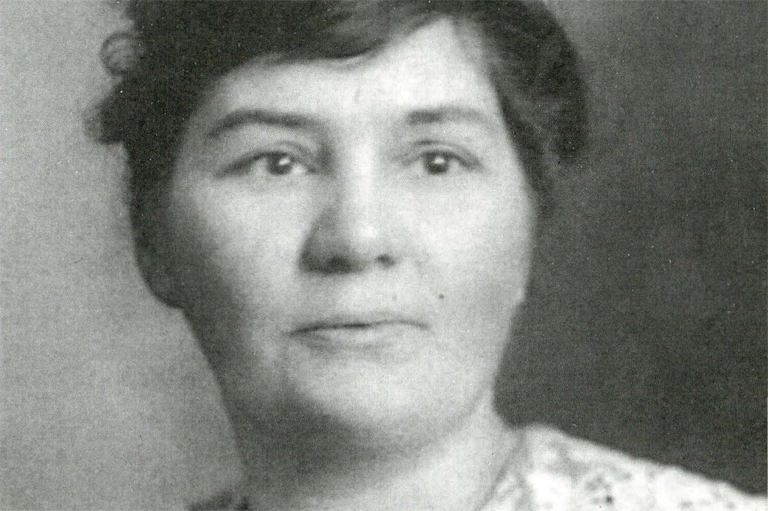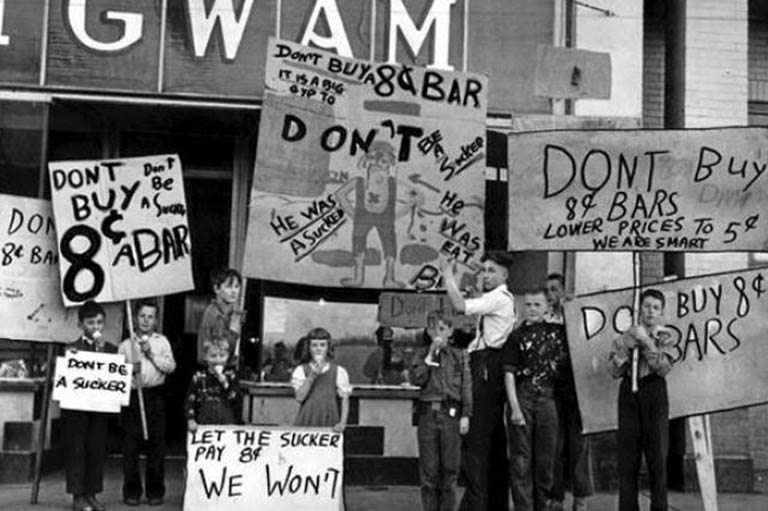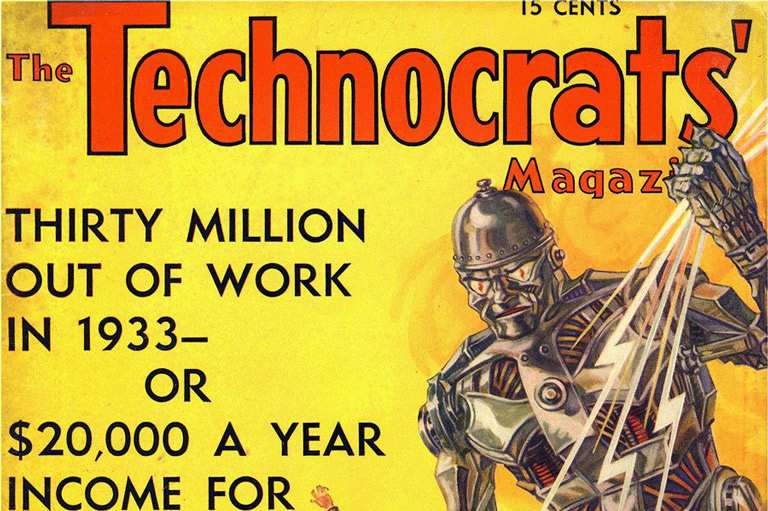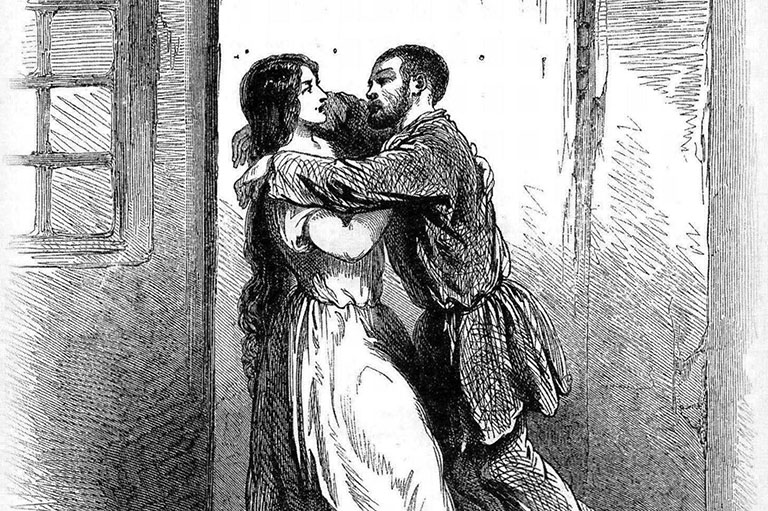A War on Two Fronts
-
 World War I brought mass mobilization to Canada for the first time. More than 600,000 Canadians fought in the trenches of France, ten percent of whom lost their lives. But veterans returned home to miserly treatment in a postwar climate of economic depression, which added fuel to an already charged labour situation.National Archives of Canada / PA 648
World War I brought mass mobilization to Canada for the first time. More than 600,000 Canadians fought in the trenches of France, ten percent of whom lost their lives. But veterans returned home to miserly treatment in a postwar climate of economic depression, which added fuel to an already charged labour situation.National Archives of Canada / PA 648 -
 Men waiting to enlist at the Toronto armouries, 1914. Despite early enthusiasm for the war when it began in August 1914, voluntary recruitment dwindled as the war became protracted. By late 1916, manpower shortages were growing in the wake of terrible casualties in France and Flanders. To compel the enlistment of citizens for military service, Parliament passed the Military Services Act in August 1917, which sowed dissent in the ranks of organized labour.City of Toronto Archives / SC 244, Item 735A
Men waiting to enlist at the Toronto armouries, 1914. Despite early enthusiasm for the war when it began in August 1914, voluntary recruitment dwindled as the war became protracted. By late 1916, manpower shortages were growing in the wake of terrible casualties in France and Flanders. To compel the enlistment of citizens for military service, Parliament passed the Military Services Act in August 1917, which sowed dissent in the ranks of organized labour.City of Toronto Archives / SC 244, Item 735A -
 Crowds on Main Street during the Winnipeg General Strike. On May 15, 1919, almost 30,000 workers left their jobs, closing Winnipeg’s factories, curtailing its retail trade, and stopping transportation and public services. Striking for collective bargaining, better wages, and improvement of working conditions, the workers remained off the job for six weeks. Manufacturers, bankers, politicians, and press called the strike a revolutionary conspiracy and convinced the federal government to step in.
Crowds on Main Street during the Winnipeg General Strike. On May 15, 1919, almost 30,000 workers left their jobs, closing Winnipeg’s factories, curtailing its retail trade, and stopping transportation and public services. Striking for collective bargaining, better wages, and improvement of working conditions, the workers remained off the job for six weeks. Manufacturers, bankers, politicians, and press called the strike a revolutionary conspiracy and convinced the federal government to step in. -
 Franco Zanetti, a.k.a. Frank Zaneth, a.k.a. Harry Blask. Zaneth, born in a village southwest of Milan in 1890, emigrated to the U.S. at the turn of the last century. After marrying in 1910, he and his wife moved to Moose Jaw, where they eventually acquired a homestead. By 1917, however, with both his marriage and his agricultural pursuits finished, he joined the Royal North-West Mounted Police and began to work undercover in the Canadian labour movement.National Archives of Canada / PA 209544
Franco Zanetti, a.k.a. Frank Zaneth, a.k.a. Harry Blask. Zaneth, born in a village southwest of Milan in 1890, emigrated to the U.S. at the turn of the last century. After marrying in 1910, he and his wife moved to Moose Jaw, where they eventually acquired a homestead. By 1917, however, with both his marriage and his agricultural pursuits finished, he joined the Royal North-West Mounted Police and began to work undercover in the Canadian labour movement.National Archives of Canada / PA 209544 -
 Anticonscription parade, Victoria Square, Montreal, May 24, 1917. Six days earlier, Prime Minister Robert Borden had announced to Parliament his intent to introduce compulsory military service.National Archives of Canada / C 6859
Anticonscription parade, Victoria Square, Montreal, May 24, 1917. Six days earlier, Prime Minister Robert Borden had announced to Parliament his intent to introduce compulsory military service.National Archives of Canada / C 6859 -
 Thirty-year-old English-born B.C. labour leader Albert “Ginger” Goodwin was classified as fit for military service when conscription became law in 1917, though he had been judged unfit earlier due to tuberculosis. After twice appealing his reclassification, he and other draft evaders hid in the bushes near Cumberland, B.C., but he was tracked down by Dominion Police special constable Dan Campbell and shot. Though charged with manslaughter, Campell was exonerated by a special inquiry.Cumberland Museum and Archives
Thirty-year-old English-born B.C. labour leader Albert “Ginger” Goodwin was classified as fit for military service when conscription became law in 1917, though he had been judged unfit earlier due to tuberculosis. After twice appealing his reclassification, he and other draft evaders hid in the bushes near Cumberland, B.C., but he was tracked down by Dominion Police special constable Dan Campbell and shot. Though charged with manslaughter, Campell was exonerated by a special inquiry.Cumberland Museum and Archives -
 Otter Internment Camp, Yoho National Park, B.C., 1916. During World War I, nationals of the German, Austro-Hungarian, and Turkish Empires were subject to internment as enemy aliens. While “reasonable grounds” had to be presented to intern someone believed to be engaged in espionage or other illegal activities, in the temper of the times pacifists, socialists, and anticonscription advocates, as well as recent immigrants, found themselves subject to scrutiny.National Archives of Canada / C 81360
Otter Internment Camp, Yoho National Park, B.C., 1916. During World War I, nationals of the German, Austro-Hungarian, and Turkish Empires were subject to internment as enemy aliens. While “reasonable grounds” had to be presented to intern someone believed to be engaged in espionage or other illegal activities, in the temper of the times pacifists, socialists, and anticonscription advocates, as well as recent immigrants, found themselves subject to scrutiny.National Archives of Canada / C 81360 -
 A period view of capital and labour from a big city daily, the Toronto Daily News, February 11, 1919.Courtesy Charles Hou
A period view of capital and labour from a big city daily, the Toronto Daily News, February 11, 1919.Courtesy Charles Hou
R.B. Russell could not believe his eyes. It was bad enough that as a high-profile member of the left-wing Socialist Party of Canada and One Big Union he was on trial for his involvement in the Winnipeg General Strike of 1919—a standoff between the city’s working and employing classes that had paralyzed the city for six weeks.
But now this: one of the Crown’s star witnesses in this highly publicized show trial, one of eight since the strikes bloody conclusion that June, was Harry Blask, a member of the SPC from Calgary who had been working as an undercover agent for the Royal North-West Mounted Police for over a year.
To stalwarts of the struggle like Russell, the presence of paid informants in the ranks of the labour movement, while infuriating, was not a complete surprise—employers had often hired private detectives to keep tabs on union activity. But as Blask’s ties to the RNWMP, time underground, and important role in securing Russell’s conviction made clear, this labour spy was no ordinary, company-hired gumshoe.
Recruited by the force in 1917, Blask was an Italian immigrant whose real name was Franco Zanetti but who renamed himself Frank Zaneth. He was sent underground in the spring of 1918, joining other new recruits whose social class, ethnicity, and language skills, the force thought, made them well suited for work among the country’s so-called undesirables: working people who opposed Canada’s war effort and, once the armistice was signed, demanded a larger slice of the capitalist pie.
Zaneth’s first assignment was in Quebec City, where he helped local and federal authorities restore order after violent anticonscription riots rocked the provincial capital. From there he moved west to Alberta, and after stops in Drumheller and Canmore, Zaneth, now known as Harry Blask, settled in Calgary and submerged himself in the local radical scene.
He moved through the ranks of the Socialist Party of Canada and attended the Western Labor Conference, a historic gathering of left-wing unionists that launched the One Big Union. Within a year, Blask was informing his RNWMP handlers of every radical activity taking place in the city, knowledge that proved useful in the wake of the Winnipeg General Strike at Russell’s trial.
After assisting the Crown in convicting the labour activist on charges of “seditious conspiracy” and having his cover blown in the process, Harry Blask’s brief career as a labour spy was, for all intents and purposes, over. But not before he had helped undermine domestic resistance to the Great War and beat back the socialist tide.
Although Blasks stint as an undercover agent was brief, it captures nicely the twin crises that faced the federal government during these tumultuous years—and, importantly, the solutions it employed to help solve them. Of particular concern to Prime Minister Robert Borden’s Conservative and later Union governments was the obvious necessity of mobilizing a diverse and politically fractious nation for war.
The second and less appreciated challenge of these years was the defence of the economic and political status quo against the twin threats of labour militancy and socialism that swept the nation during the Canadian labour revolt of 1917—20.
The revolt—which climaxed in 1919 with the confrontation at Winnipeg and a wave of sympathy strikes that followed the arrest of Russell and other strike leaders—was the first significant nationwide challenge to capitalist rule. Taken together, the significant problems posed by the war—the presence of large immigrant communities from enemy nations resident in Canada, the need for secrecy about the war effort, and resistance to conscription—coupled with the labour unrest of the period, prompted Ottawa to create the legislative and institutional means necessary to undermine internal dissent.
The federal government, then, was waging a war on two fronts, one in which men like Harry Blask and, more importantly, the fledgling spy network of which he was a part, played a decisive role. In short, in the crucible of both world war and class war, the Canadian secret service—today associated with the RCMP and the Canadian Security and Intelligence Service (CSIS)—was born.
Among the first actions of the Borden government after the outbreak of hostilities in Europe was to invoke the War Measures Act, a move that assured the prime minister and the cabinet, the executive arm of the federal government, the maximum power possible to pursue the course of war.
“The Governor in Council shall have power to do and authorize such acts and things, and to make from time to time such orders and regulations, as he may by reason of the real or apprehended war, invasion, or insurrection deem necessary for the security, defence, peace, order, and welfare of Canada,” its preamble read, laying out the executives new, unbridled powers.
Unprecedented in the annals of parliamentary government, the “orders and regulations” permitted under the act—called “orders-in-council” or “Privy Council Orders”(PC)—took aim at a wide range of concerns, including the “censorship,” “control,” and “suppression” of all “means of communication” and the “arrest,” “detention,” and “deportation” of citizens deemed harmful to the war effort. Such decrees did not require the approval of Parliament to become law, nor did they possess either a time limit or independent mechanism for termination.
In short, as historian Arthur Lower observed over thirty years ago, the Borden government had effectively replaced parliamentary government during the First World War with an order-in-council government—and it wasted little time in flexing this new, all-powerful muscle.
In late October, Ottawa demanded that all “enemy aliens”—its phrase for immigrants from enemy nations residing in Canada—appear for registration and examination before special registrars or local police in major centres. Those men and women deemed nonthreatening were either allowed to leave Canada or to remain free under condition they report monthly to the registrar.
“Enemy aliens” considered dangerous or who failed or refused to register were interned as prisoners of war. In an initial wave of enthusiasm, some six thousand aliens, most of whom were Ukrainians, not Germans, found themselves interned. That most Ukrainian-Canadians passionately hated the Austro-Hungarian Empire made no difference.
The federal government followed this aggressive move by creating the office of the chief press censor in July 1915 to monitor and, if need be, shut down publications critical of the war, a task that once fell to the military and post office. Originally instructed to take aim at the foreign-language press, the office’s mandate was expanded in subsequent years to include any materials considered hostile to conscription or the war effort.
The government also faced the daunting task of recruiting Canadians for the armed services. As early as the summer of 1915, recruiters began to complain of difficulties attracting adequate numbers of soldiers. Consequently, the Borden government, under heavy pressure from various upper-class patriotic groups, created the National Service Board (NSB) on August 1, 1916, and appointed a director-general of national service to undertake a voluntary survey of potential soldiers.
In the face of considerable criticism from both organized and unorganized workers, the prime minister assured the country that the voluntary nature of national service “render[ed] unnecessary any resort to compulsion.” Conscription, it appeared, was not in the offing. The leaders of the Trades and Labor Congress, the national umbrella organization of trade unions, accepted Borden’s argument and recommended full compliance to its affiliated unions, abandoning their original antidraft mandate, which they had sought and received in August 1916.
In the eyes of many trade unionists, it was a stunning reversal, one that effectively divided the labour movement over the progress of the war.
In the aftermath of the TLC leadership’s acceptance of national registration, a storm of protest arose from Canadian workers. When Ottawa decided in late May 1917 to proceed with conscription—a move prompted by both the failure of other voluntary schemes and pressure from the Imperial War Cabinet in England—and passed the Military Service Act that August, opposition grew fierce. Talk of general strikes and even revolution filled the air.
“There were two major views of the War, that of the exploiter and that of the exploited, declared Alphonse Verville, the sitting Liberal-Labour member of parliament for Montreal-Hochelaga. The ensuing 1917 federal election campaign was punctuated by anticonscription demonstrations but ended in a convincing victory by the pro-war Union government, a victory gained, at least in part, by electoral shenanigans of a previously unheard of level in Canadian general elections.
For the mainstream labour movement, the conscription debate came to a head at the September 1917 TLC convention in Ottawa. The organization’s executive took the easy position that because the Military Service Act was law, labour could not afford to oppose it. Delegates saw things differently and called for a militant stand.
After hours of fiery exchange, general opposition to conscription of manpower prevailed—though fears of government repression led to the defeat of a more radical motion that labour would back conscription of manpower only if wealth, too, was conscripted. Although the national trade union leadership bowed out of the struggle against compulsory service, the fight did not end there.
Those who resisted the Military Services Act took action in many ways. Applying for an exemption was the easiest method. Of the first 160,000 men called to report, fully 92 per cent did just that. By the end of 1917, some 73 per cent of those seeking exemptions had been successful.
Others took more radical action. In Quebec City on Easter weekend 1918, anticonscription demonstrators sacked the offices of pro-Borden newspapers and the registrar of the MSA and later clashed with troops sent to restore order—confrontations that left four workers dead.
On the West Coast, on August 2, 1918, thousands participated in Canada’s first political general strike to protest the killing of miners’ leader and MSA defaulter Albert “Ginger” Goodwin, who had been shot, allegedly in self-defence, by Dominion Police special constable Dan Campbell. (Campbell was later exonerated by a special inquiry.)
The Borden government had imposed conscription over the healed objections of Canadian labour, but it had done so at considerable cost: by calling the moderate leadership of the TLC into disrepute, it helped pave the way to the massive labour revolt that peaked in the summer of 1919.
From 1917 to 1920, unprecedented levels of class conflict rocked Canada. The climax of this labour revolt took place in 1919, when about 150,000 workers participated in 428 separate confrontations, including local battles, wider general strikes that shut down entire industries and cities—the largest and best-known taking in place in Winnipeg—and sympathy strikes held in solidarity with the men and women on the picket lines in the Manitoba capital.
From coast to coast, workers in nearly all sectors of the economy, from telephone operators and waitresses to miners and loggers, confronted both employers and the government for higher wages, better working conditions, and union recognition. Others called for a “new democracy based on production for use, not for profit.
Surveying the situation in the eye of the storm in Winnipeg, the commissioner of the Royal North-West Mounted Police, A.B. Perry, remarked: “The greater number of labour men, and probably the community as a whole, are in an uncertain, apprehensive, nervous and irritable temper. Perhaps these agitators are but the foam on the wave.”
The causes of this wave of unrest were legion. On the home front, manufacturers continued to make massive profits, while wartime inflation pushed the cost of living higher and higher, making it extremely difficult for workers and their families to make ends meet. At the same time, the notion that collective struggle was both necessary and just was emboldened by the spread of trade unionism into previously unorganized areas in 1918.
Letter carriers in Vancouver, firefighters in Edmonton, civic workers in Winnipeg, and, most alarming of all to the Canadian upper class, police officers in many large cities signed union cards. Overseas, the Russian Revolution and the subsequent tide of revolts across Europe stimulated Canadian socialists who were already battling the government’s wartime polices and debating the possibilities of postwar reconstruction.
Other, longer-term factors were important as well. From the turn of the century to the eve of the war, Canadian capitalism underwent a significant transformation. The small shops of the skilled artisans slowly gave way to larger, more sophisticated factories, a process that gutted skilled trades, brought more workers together into larger workplaces, and, as a result, enhanced their capacity for collective action.
At the same time, working-class districts, like those linked to the huge metal plants and railroad shops across the country, became the centres of workers’ lives, generating distinct cultures and institutions that helped widen circles of struggle beyond the work-place.
Finally, the working class, which ballooned with new immigrants from eastern and southern Europe in the prewar years, had by 1919 undergone a notable transformation of its own. It matured, coalesced, and to some degree at least, commenced the process of incorporating new workers into the movement—Jewish, Ukrainian, and Finnish women and men who often possessed socialist backgrounds.
Drawn together in the electrified context of the Great War, these conditions produced an unprecedented level of class conflict in 1919 alone, the equivalent of almost 3.S million days of work were lost to industrial strife. From the anticonscription agitation to the summer strike wave, the war came home with a vengeance.
It certainly did not await the return of the Canadian troops after the November 1918 armistice. Not surprisingly, the unrest of this period aroused the fears of the Canadian government, prompting an intensification of repression and a Red scare of ample proportions.
Internment, which had been used less and less in 1915 and 1916, made an instant recovery. Although authorities had harassed socialist and pacifist opponents of the war in its early years, their efforts grew massively in this period of unrest. “Foreign aliens” charged with anything related to radical politics—possession of prohibited literature, attendance at illegal meetings, membership in an illegal group—found themselves whisked away to internment camps.
Indeed, in February 1919, as the summer strike wave was just starting to heal up, the government considerably expanded the camps’ potential by allowing any county- or district-court judge, on a summary complaint from a municipal authority or any reasonable citizen, to intern on grounds no greater than a “feeling of public apprehension entertained by the community.”
When the camps were finally closed fifteen months after peace in Europe, nearly nine thousand men, women, and children had been interned, of which only a third, by Ottawa’s own admission, could even remotely be considered conventional prisoners of war. Some eighty thousand other foreign-born Canadians had passed through the registration and examination procedures without being detained.
As dramatic as internment, however, was the government’s suppression of two other democratic freedoms. On September 25, 1918, Ottawa passed PC 2381, an order-in-council that curtailed freedom of the press by banning all publications in an “enemy language.” Many left-wing labour newspapers were closed down; so, too, were all Finnish and Ukrainian publications, radical or not.
Equally striking was PC 23K4, a decree that drastically curtailed freedom of association, assembly, and speech for a select group of Canadians, most of whom were foreign immigrants. Illegality, in effect, became retroactive, as the order presumed “in the absence of proof to the contrary” that the accused was a subversive if, since the outbreak of the war, he or she had “repeatedly” attended meetings of a banned group, spoken publicly about its ideals, or distributed its literature.
Under such rules of engagement, the Dominion Police and the Royal North-West Mounted Police participated in an extraordinary wave of arrests, prosecutions, and convictions of alleged subversives. Working to the east of Lake Superior, the Dominion Police, with the assistance of provincial and local forces, carried out extensive undercover work that led to the arrest of dissidents in Sault Ste. Marie, Toronto, Windsor, Montreal, Welland, and Hamilton.
“The spirit of Bolshevism is strong among the aliens in this country and the Russians and the Finns are the class that requires the most attention,” the superintendent of the Ontario Provincial Police wrote in 1919.
In the West, fresh from a week-long stint in jail orchestrated by the RNWMP to bolster his revolutionary credentials, Harry Blask was busy ingratiating himself to George Sangster, a Calgary machinist and prominent radical, and gaining access to the local left-wing scene. In the wake of the Winnipeg General Strike, he made his infamous appearance at Russell’s trial, despite the RNWMPs initial misgivings about losing one of its most effective labour spies, and was subsequently promoted into the upper echelons of the force.
Clearly, intelligence and security matters were on the government’s political front burner. According to one police report entitled “Bolshevik Propaganda,” between the fall of 1918 and June 1919, 214 men and women, most of them of Finnish and Slav ancestry, were charged with various offences, including possession of prohibited literature, attending illegal meetings, and being members of banned organizations.
Not only was the federal government mobilizing to fight the enemy abroad, but, increasingly, the enemy was seen to be at home too. To bring it to heel, though, it had to put internal security and intelligence matters on a more secure, bureaucratic footing.
As conflicting and incomplete reports concerning the nature of unrest in the country poured into Ottawa, the Borden government commissioned Montreal lawyer C.H. Cahan to draw up a report on socialist and left-wing activities in Canada. Reporting to the minister of justice in September 1918, Cahan confirmed the government’s worst fears about foreign agitators and Bolshevik agents.
In addition to raising the spectre of a creeping “Red menace,” Cahan recommended that the government create more permanent internal mechanisms to carry out a systematic and coordinated countersubversive strategy.
Shortly after filing his report, Cahan accepted a new position as director of the Public Safety Branch of the Department of Justice, with an ambiguous mandate to advise on security matters. He held the position only until January 1919, then quit in protest when the Union government resisted some of his more aggressive efforts.
In the wake of the summer strike wave, Ottawa set about building an institution capable of coordinating such repression on a national basis. It broadened the mandate of the RNWMP, granting it complete jurisdiction in the area of federal law enforcement and national security. Within this wider framework, a new Criminal Investigation Branch (CIB), responsible for the running of detectives and spies across the country, was established at Regina headquarters.
A year later, the older Dominion Police force was quietly merged into the larger RNWMP to produce the Royal Canadian Mounted Police, and the new forces headquarters were moved to Ottawa to emphasize its new national role.
Once in the nation’s capital, the RCMP expanded its security work further by creating a central registry—an extensive archive of the country’s so-called undesirables—and, later, by appointing a liaison and intelligence officer. This position produced weekly summaries of security and intelligence material collected by the force for the perusal of the prime minister and cabinet.
Thus, by 1922, with the creation of the CIB, the central registry, and the office of the liaison and intelligence officer, the security state had arrived in Canada. While the labour activism that prompted these extraordinary actions would dwindle in the political and economic climate of the 1920s, Ottawa’s new security apparatus, operating out of the Department of Immigration and Justice and through military intelligence and the RCMP, would remain alert through the Great Depression, the next period of nationwide worker militancy.
And, as the twentieth century progressed, through the Cold War and periods of domestic insurgency such as the FLQ crisis, it would consolidate its position not only as the government’s monitor of labour activists but of political and social dissenters of all kinds.
The Insider

To Canada’s political and business elite, G.H. Cahan’s appointment as director of the Public Safety Branch of the Department of Justice was perhaps not a complete surprise. Born in Nova Scotia in 1861 to a Presbyterian family, Cahan attended Dalhousie University, graduating with an LLB in 1890 and BA in 1896.
After several years with the influential Herald and Mail, he turned his attention to corporate law and parly politics—two pursuits that would dominate his public life for nearly half a century.
As a lawyer, Cahan, who was called to the bar in both Nova Scotia (1893) and Quebec (1908), worked a great deal with Canadian companies, like Mexican Light and Power, incorporated in 1902, that were active in the developing world.
Throughout the early 1900s, Cahan’s stable of corporate clients expanded considerably with the addition of investors from the United States, United Kingdom, Germany, British Guyana, and Trinidad.
“Mr. Cahan is generally accepted as the mouthpiece of the Holt, Gundy and other big business interests of Montreal,” the British High Commissioner in Ottawa remarked candidly in 1929. Echoed Max Aitken, the future Lord Beaverbrook, commenting years later on the period in which Cahan handled the affairs of his Royal Securities Corporation: “He was well paid. His legal fees were large—too large for that age.”
Caban’s political ambitions, like his legal fees, were large too. In 1890 he was elected to the Nova Scotia legislature and served as leader of the Conservative opposition for four years. But his success on the provincial hustings was shortlived. He ran unsuccessfully in two subsequent provincial elections in 1896 and 1900.
Eleven years later, Cahan, who by then was wealthy and had moved permanently to Montreal, was working as an organizer for the federal Tories, then under the leadership of Robert Borden, himself an attorney from Nova Scotia. During the 1911 federal election, a battle that turned on the controversial issue of free trade, Cahan helped broker an alliance with Quebec nationalists and, in so doing, delivered twenty-seven seats to the Conservatives, helping the party defeat Wilfrid Laurier’s Liberals.
During World War I, Cahan, who ran unsuccessfully for the Tories in 1917, worked his political and business connections to help procure munitions from the United States for the Allied forces, a move made possible by his presence on the board of Canadian Car and Foundry, a Montreal-based operation with plants in the U.S. that was involved in wartime production.
Some sources suggest that Cahans first taste of intelligence and security work came in early 1917 when he was asked to investigate a mysterious explosion at Canadian Car’s New Jersey plant—a blast thought to be the work of German saboteurs.
Less than a year later, just as the labour revolt was starting to congeal, the Borden administration asked him to draw up a report on left-wing activities in Canada—a document that prompted further repression of working people’s democratic freedoms.
Cahan was subsequently appointed director of public safety, a position he held until early 1919 when he resigned to protest Borden’s foot-dragging on his more ambitious plans. His political career, however, was by no means over. He was finally elected to the House of Commons in 1925 and reelected in 1926, 1930. and 1935. During the Bennett administration he served as secretary of state.
Defeated in the 1940 federal election, the staunch conservative retired from public life. He died four years later in Montreal at the age of eighty-three.
This sidebar is based in part on archival and secondary research carried out by Michael Butt, whom the authors wish to thank for his assistance.
Et cetera
Workers and Canadian History by Gregory S. Kealey. McGill-Queen’s University Press, Montreal and Kingston, 1995.
Undercover: Cases of the RCMP’s Most Secretive Operative by James Dubro and Robin Rowland. McClelland & Stewart, Toronto, 1990.
Ginger: The Life and Death of Ginger Goodwin by Susan Mayse. Harbour Publishing, Madeira Park, B.C., 1990.
Broken Promises: A History of Conscription in Canada by J.L. Granatstein and J.M. Hitsman. Copp Clark Pitman,Toronto, 1985.
The Winnipeg General Strike of 1919: An Illustrated History by J.M. Bumsted. Watson & Dwyer, Winnipeg, 1994.
On Strike: The Winnipeg General Strike, 1919, a twenty-minute film produced in 1991 by the NFB, is available through local libraries.
The Canadian Museum of Civilization’s survey of Canadian labour history between 1850 and 1999 can be found at Labour’s Revolt.

